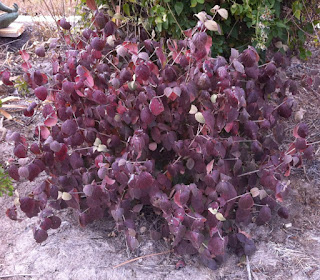 |
| Viburnum juddii |
When a cold, blasting wind took the leaves off of most of the trees in my garden, my autumn color melted from the sky to the ground, leaving mere remnants of color dotted around my landscape. Fortunately, I have a number of viburnums in my garden beds, each of which now had to carry more than its burden of beauty to make up for brown grasses and leafless deciduous shrubs.
 |
| 'Roseum' |
Viburnums, some of them anyway, are two- and sometimes three-season plants for my garden, providing some nice bloom and fragrance for the Spring garden, and then either some leaf color or colorful fruits in the Fall. When I speak of color, of course, I'm not speaking of the forthright crimson of an 'Olympiad' rose, the blazing orange of an October pumpkin, or even the bright red of a burning bush, but more the muted purple of a
Viburnum juddii like the one at the upper right, or even the brighter red of the 'Roseum'
Viburnum opulus at the left.
 |
| Viburnum burkwoodii |
My favorite of the "colorful" viburnums, at least in this unusually dry year, is the
Viburnum burkwoodii that occupies a center spot in my border. This guy is turning red leaf by leaf, and right now looks like a winter holly with the spotted red against the dark green background.
 |
| 'Mohawk' |
A similar mottled pattern, with more yellow tones, is exhibited by
Viburnum fragrans "Mohawk", seen at left. This viburnum is more of a "Joseph's Coat" plant, with a rainbow of greens, oranges, yellows, and reds (and browns) found on the same bush. Not as pretty to me as the V. burkwoodii, but the Spring fragrance in 'Mohawk' makes up for what it may lack in the Fall.
 |
| 'Synnestvedt' |
The ugly sisters of the group are a few "Fall-challenged" viburnums, such as the 'Synnestvedt'
Viburnum dentatum at the right. 'Synnestvedt' is trying to turn yellow, but doing a poor job of it, losing leaves as fast as they turn. I also have eight or ten other viburnum cultivars and species, but many have already dropped their leaves and are ready to face the winter naked and spindly. If we turn out to have a bad winter, these, of course, will be the brainiacs of the bunch, placing their faith in hardened buds that will swell with the coming of Spring.













